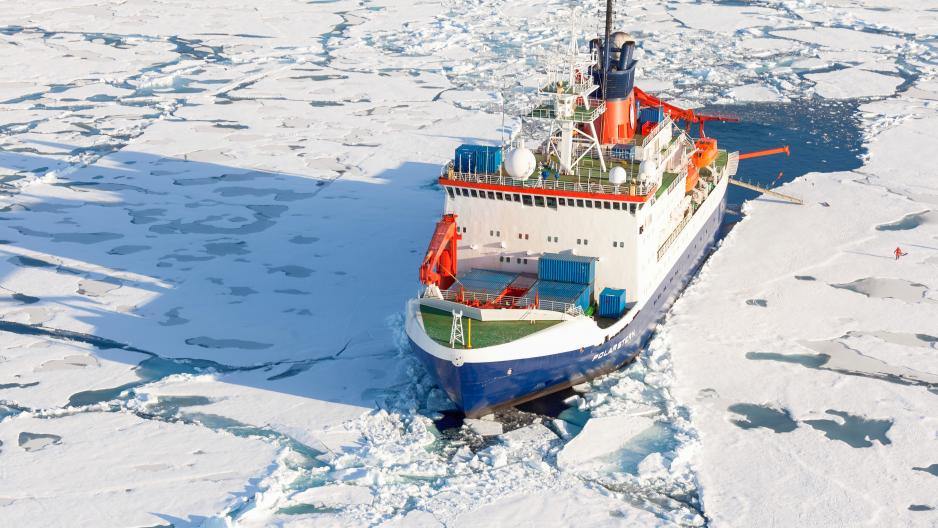Countries from Three Continents Cooperate on New Large Arctic Research Project

"The largest Arctic research expedition ever", says Professor Markus Rex about the MOSAiC project with 60 institutions from Europe, Asia, and North America.
Led by the German Alfred Wegener Institute, Helmholtz Centre for Polar and Marine Research (AWI), a large consortium of international partners will launch the Multidisciplinary drifting Observatory for the Study of Arctic Climate (MOSAiC) project in May 2018.
Largest expedition ever
"This is the largest Arctic research expedition ever", says Professor Markus Rex, head of the Atmospheric Physics Section at AWI and Professor for Atmospheric Physics at the University of Potsdam who coordinates the project with 60 institutions from Europe, Asia, and North America.

"The large and diverse group of partners shows that fruitful international collaboration in science is independent from the sometime conflictive geopolitical situation", Prof. Rex emphasises.
What is the overarching goal of the MOSAiC project and when will it take place?
"The official start of the project is in summer 2018, which is close to the historical date of the 150th anniversary of German polar scientist Carl Koldewey’s "Polarfahrt", which commenced on 24 May 1878 and is regarded as the start of German Polar research. It also marks the 125th anniversary of the start of Fridtjof Nansen’s Fram expedition in summer 1893 - the historic example for the MOSAiC endeavour. The actual MOSAiC expedition will start in mid-September 2019 and will last one year until the end of September 2020.
Drifting with the sea ice
The overarching goal of the project is to improve the understanding and model representation of coupled atmosphere-ice-ocean-ecosystem processes in the central Arctic to support improved climate and sea ice projections and regional weather forecasting.
The idea is to let our flagship, the German research ice breaker Polarstern, drift with the natural drift of the sea ice through the central Arctic, across the polar cap. During the drift we will be solidly frozen into the thick winter and spring sea ice. This sea ice is too thick to be broken by research ice breakers and drifting with the ice is the only way to reach the central Arctic during these seasons. This is why observations from the central Arctic are extremely sparse for these months."
More than 60 partners
How many partners from how many countries are involved in the project?
"MOSAiC is led by the German Alfred Wegener Institute, Helmholtz Centre for Polar and Marine Research, and has more than 60 institutional partners from 16 nations. Many European countries play major roles in MOSAiC. There are also strong Norwegian partners in the consortium and MOSAiC interacts and collaborates intensely with the Norwegian Nansen Legacy project. Beyond Europe, MOSAiC is a particularly strong partnership between Russia, USA, China, and Germany. MOSAiC thus demonstrates that trusting and fruitful international collaboration in science is independent from the geopolitical situation or sometimes conflicting national interests."
What are the anticipated outcomes of the project?
"We will close key knowledge gaps in understanding the Arctic climate system and specifically the strong amplification of climate change in the Arctic. Unique new observations of climate processes in the Arctic will lead to a better representation of the Arctic climate in Earth System Models and Numerical Weather Forecast Models.
Will improve climate projections
Better projections of the Arctic climate will provide a more robust scientific foundation for planning and regulating the strong economic growth in the Arctic and are thus needed as a basis for the investments of hundreds of billions of US$ into ongoing and planned Arctic infrastructure projects. Improved model representations of these key processes will also contribute to more reliable weather and sea ice forecasts in the Arctic, which are urgently needed for the safety of increasing shipping activities in Arctic waters.
Finally, a better understanding of Arctic climate processes will also improve climate projections in North America, Europe, and Asia and will help understanding trends in severe weather occurrences in these densely populated areas."
What are the major challenges in planning and implementing such a project?
"The two major challenges are the sheer size of this project and the challenges of carrying out such a big operation in one of the most adverse climate zones of our planet. MOSAiC now has a total budget of close to 150 million Euro and is the largest Arctic research expedition ever.
A network of research stations
MOSAiC does not only consist of the measurements of Polarstern, which will be our central observatory, but also includes the setup of a network of research stations on the ice. We will coordinate the operations of five ice breakers, two research aircraft, and supporting helicopter and aircraft. Fuel depots will be set up on the northernmost Islands in the Arctic to support the helicopter operations and ensure a closed emergency and evacuation chain for potential medical emergencies on board. Runways will be prepared on the ice to allow research and support aircraft to land and refuel in the Central Arctic.
Overall, these operations under Arctic climate conditions, thick sea ice cover, and the darkness of the polar night can only be carried out by a collaboration of the world’s leading polar research institutions under the leadership of AWI."
